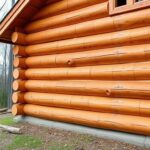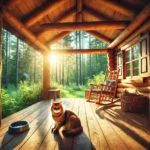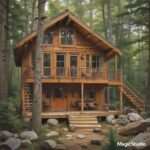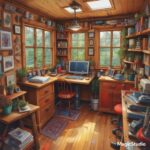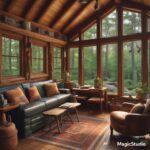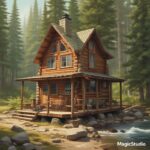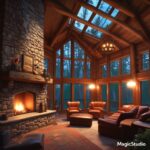Building a very small cabin creates a number of limitations, but also a huge variety of poses for making the most of available space and designing a very comfortable space, despite its tiny dimensions. Living in a very small cabin all 1 sq ft counts, and by thinking about it (and planning well) it is possible to evolve even a simple plan into an effective and pleasant one. In this guide, we’ll explore the best layout ideas and design tips for making the most of your tiny cabin.
1. Open Floor Plans for Spaciousness
Perhaps the simplest way to interior design a small cabin to look and/or feel larger is by taking one of the suggestions for an open floor plan. Removing unnecessary walls creates a seamless flow between different areas, such as the kitchen, living room, and sleeping space.
Key benefits of open floor plans:
- Improved natural light, making the cabin feel airy.
- Flexibility to rearrange furniture and optimize space.
- Easier to maintain a clean and uncluttered appearance.
For physical contiguity, use rugs, differing ceilings, or reconfigured furniture as delimiting lines between areas.
2. Multi-Functional Spaces
As there is limited space, every single square inch has to deliver all its chips to all the others. Multi-function sites are of particular importance for both activity co-location to reduce clutter, as well as the intended reduction of clutter.
Practical examples:
- A dining table that doubles as a workspace. Store it when not in use in a collapsible or extendible table).
- A living area with hidden storage. Intramural boxers with inbuilt storage compartments can provide a means of storing things such as clothing or a book.
Sleeping compartments above the common living space to maximize floor space.
These solutions enable you to experience how things work in the cabin, without constraint.
3. Loft Designs for Vertical Space
Residential small cabins can be without horizontal area of the floor but usually are equipped with great high ceilings so that they can be effectively used. Lofts represent a versatile solution for sleeping space as the area underneath the floor is not occupied.
Tips for an efficient loft layout:
Access lofts by ladders or stairs by which inbuilt storage can be accessed to achieve the full functional capacity of the loft bed.
For lofts in particular, design things people can have easy access to at ground level (e.g., floor beds, narrow mattresses).
Install skylights or windows for ventilation and daylighting to give the loft the impression of being bigger.
The flexible nature of lofted spaces means it can be used as a bed room, storage and even a small library.
4. Clever bedroomDesigns
Be, cause the kitchen is usually the busiest room in a cabin, it makes sense to plan as much as possible to establish an efficient, but compact space.
Space-saving ideas for tiny cabin kitchens:
- Compact appliances: Select mini refrigerators, mini stoves, and mini dishwashers to not take up counter space.
- Vertical storage: Wall-mounted shelves, magnetic strips, and plant pot/cooking utensil/utility tool hanging racks.
Pull-outs tables or dropleaf tables widen out into a workspace during the cooking and eating process (for example, imagine protractors, pulleys, and sliding heads).
Such means are possible to equip a kitchen, which is silent.
5. Built-In Furniture for Efficiency
Built-in furniture is a game-changer for tiny cabin layouts. If you can measure furniture accurately to size a room, you can avoid awkward areas and make the best use of the space available in your cabin.
Examples of built-in furniture:
Skylight windows with hidden storage for books, bedsheets, or camping gear.
Murphy beds that fold when not in use to give more living space.
Built-in desks and shelves for a small office/reading room.
Due to one-to-one fitted furniture, every centimeter and corner of your cabin is utilized best.
6. Zoning with Sliding Doors and Curtains
Even though open layouts of a small cabin are a good design, privacy is occasionally required. Sliding doors and curtains provide an attractive way of splitting up the space, and no additional floor space is needed.
Where to use sliding doors or curtains:
From isolating the sleeping loft/bedrooms from the living space.
- Between the bathroom and main cabin space.
For concealing storage or for building a passageway.
These unobtrusive versions are not as heavy as conventional doors and therefore an open space is retained.
7. Outdoor Extensions
If space is a constraint in the indoor environments, go out of it (i.e. Miniature cabins are often equipped with decks, patios or screened porches in order to add to the square foot,tage that can be used.
Ideas for outdoor layouts:
- Dining areas: Add a small table and chairs for outdoor meals.
- Relaxation zones: Both lounge chairs, hammocks, and/or a fire pit are available for enjoying the peacefulness.
- Outdoor kitchens: Establish a grill or prepping station for outdoor cooking.
Extensions to the exterior have the effect of giving the feel of a bigger cabin which detaches you from the exterior world.
8. Light and Bright Interiors
The strategic use of light has a significant effect on the perception of cabin size. Natural light, deep color, and mirrors can give the sensation (of making the relatively small cabin look a lot bigger).
Tips for light and bright interiors:
- Large windows: Maximize natural light and provide stunning views.
- Light-colored walls and ceilings: White or pale colour should be employed in the room to obtacolorpacious, airy room.
- Mirrors: Emtogic use of mirrors to scatter light, and thus produce a larger scale effect.
With good light, a bright, airy cabin interior gives the feeling of warmth and improved room size, even though it is a room of limited size.
9. Efficient Bathroom Layouts
Bathrooms can be difficult rooms in which to design a small cabin, but good planning leads to both practical and visually appealing bathrooms.
Ideas for compact bathrooms:
- Corner showers: Use triangular or corner shower units to save space.
- Wall-mounted sinks and toilets: ** Free up floor space while maintaining functionality.
- Sliding barn doors: Eliminate the need for swing doors in tight spaces.
With an appropriate layout, your bathroom can include all of the opulence one might desire without it being cramped.
10. Personal Touches and Decor
Although utility is fundamental, there is magic in bringing some personal touches together, turning your tiny cabin into a proper home. Household items should be minimal, but powerful, evoking communion, and creating an impression of space without adding extra clutter.
Personalization Tips:
Select generic items (Tipsets or trays, for example, which are storage items).
Just put a few souvenirs or special possessions in the room to give it character but leave it sparsely furnished.
To create a cozy, reassuring mood in the space, use cushions and rugs.
These are the finer points that enable you to optimize the balance between utility and usability.
Conclusion
The tiny cabin design is all about ingenuity, working within the limits of space, and maximizing the space at hand. Openness, loft seating/beds, integrated furnishings, and outdoor spaces, just to mention a few, underlie a very wide spectrum of possibilities to take advantage of both the functionality and esthetic quality.
By adopting some of these ideas for layout and tailoring them to your requirements, you can achieve a cozy, comfortable, and individually designed petite cabin. By the way, it’s not about the size of the cabin, but how you fill the space to let it become a house that conforms to your lifestyle and character.


